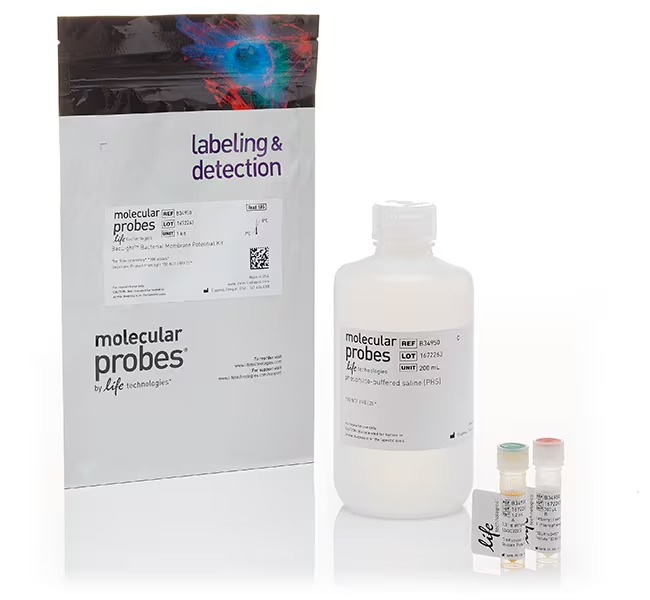Invitrogen™ BacLight™ Bacterial Membrane Potential Kit
Catalog No :
CAS Number :
Brand :
In Stock
Specifications:
| Application | Flow Cytometry, Cell Analysis | ||
| Storage Temperature | 2-8°C | ||
| Product Type | Molecular Biology Reagent | Forms | Kit with Various components |
| Product Brand | Thermo Fisher Scientific™ | ||
| Product Grade | Molecular Biology | ||
The BacLight™ Bacterial Membrane Potential Kit is a fluorescence-based assay designed for the detection and quantification of bacterial membrane potential using flow cytometry. It includes DiOC2(3), a membrane-potential-sensitive dye, and CCCP, a proton ionophore control that eliminates bacterial membrane potential.
✔ Quantifies bacterial membrane potential using flow cytometry
✔ DiOC2(3) fluoresces green in all bacteria and shifts to red in energized cells
✔ CCCP control included to confirm membrane potential disruption
✔ Compatible with a wide range of bacterial species
✔ For Research Use Only. Not for diagnostic procedures.
Key Features & Benefits
✔ Real-Time Detection of Bacterial Membrane Potential
- DiOC2(3) exhibits green fluorescence in all bacteria and accumulates in bacteria with intact membrane potential, shifting fluorescence from green to red.
✔ Flow Cytometry-Compatible for High-Throughput Analysis
- Enables quantitative, single-cell resolution analysis of bacterial membrane potential changes.
- Allows rapid differentiation of active vs. depolarized bacterial populations.
✔ Includes CCCP as a Positive Control
- CCCP (Carbonyl cyanide 3-chlorophenylhydrazone) disrupts membrane potential by eliminating the proton gradient.
- Used to establish baseline fluorescence for depolarized bacterial populations.
✔ Simple, Easy-to-Use Protocol
- Requires minimal sample preparation and no washing steps, reducing processing time and sample loss.
- Works with a variety of bacterial species, including Gram-positive and Gram-negative bacteria.
✔ Ideal for Multiple Research Applications
- Antimicrobial efficacy testing
- Bacterial physiology and viability studies
- Biofilm research and antibiotic resistance mechanisms
- Microbial stress response studies
Applications & Use Cases
1. Antimicrobial Susceptibility Testing (AST)
- Purpose: Evaluate the effects of antibiotics and antimicrobial agents on bacterial membrane potential.
- Use Case: Researchers use BacLight™ to test the potency of new antibiotics by assessing bacterial depolarization.
2. Bacterial Viability & Metabolism Studies
- Purpose: Differentiate between active, dormant, and dead bacteria based on membrane potential.
- Use Case: Used in microbiome research to study bacterial metabolic activity in gut flora and environmental samples.
3. Biofilm Formation & Drug Resistance Research
- Purpose: Investigate how bacteria in biofilms maintain membrane potential under stress.
- Use Case: Used in pharmaceutical research to study how biofilm-embedded bacteria resist antibiotics.
4. Stress Response & Environmental Microbiology
- Purpose: Assess bacterial adaptation to pH changes, oxidative stress, and nutrient deprivation.
- Use Case: Used in ecology and environmental microbiology to measure bacterial responses to pollutants.
5. Bacterial Pathogenesis & Host-Pathogen Interaction Studies
- Purpose: Determine the role of membrane potential in bacterial virulence and survival inside host cells.
- Use Case: Used in infectious disease research to study how pathogenic bacteria evade immune responses.
Product Specifications
| Attribute | Details |
|---|---|
| Product Name | BacLight™ Bacterial Membrane Potential Kit |
| Catalog Number | B34950 |
| Detection Method | Fluorescence |
| For Use With (Application) | Membrane Potential Assay |
| For Use With (Equipment) | Flow Cytometer |
| Dye Type | Membrane Potential Probes |
| Emission Wavelength | 482/497 nm |
| Format | Tube(s) |
| Product Line | BacLight™ |
| Quantity | 1 Kit |
| Shipping Condition | Wet Ice |
| Unit Size | Each |
Kit Contents & Storage
✔ Kit Includes:
- DiOC2(3): 1.2 mL of 3 mM solution in DMSO
- CCCP (Proton Ionophore): 300 µL of 500 µM solution in DMSO
- PBS (Phosphate Buffered Saline): 200 mL
✔ Storage Conditions:
- Store at 2–8°C (refrigerated).
- Protect from light to prevent degradation.
- Do not freeze the reagents.
How the Assay Works
Step-by-Step Protocol:
-
Prepare Bacterial Samples
- Grow bacteria in appropriate media and prepare them at a suitable concentration.
-
Stain with DiOC2(3)
- Add DiOC2(3) dye directly to bacterial samples.
- Incubate at room temperature to allow dye uptake.
-
Add CCCP (Optional Control)
- If assessing membrane potential loss, treat a subset of bacteria with CCCP to depolarize their membranes.
-
Analyze by Flow Cytometry
- Measure red and green fluorescence intensity shifts in bacterial populations.
- Compare untreated vs. CCCP-treated samples to determine membrane potential changes.
Ordering Information
| Catalog Number | Description | Quantity |
|---|---|---|
| B34950 | BacLight™ Bacterial Membrane Potential Kit for Flow Cytometry | 1 Kit |
Regulatory & Compliance Information
- For Research Use Only (RUO) – Not intended for diagnostic procedures.
- Manufactured under strict quality control standards to ensure high reproducibility and accuracy.
The BacLight™ Bacterial Membrane Potential Kit provides a powerful, fluorescence-based approach for measuring bacterial membrane potential using flow cytometry. Its red-to-green fluorescence shift allows for quantitative assessment of bacterial viability, metabolism, and antibiotic susceptibility.
With its simple, rapid protocol and compatibility with multiple bacterial species, this kit is an essential tool for microbiologists, infectious disease researchers, and pharmaceutical scientists studying bacterial physiology, antimicrobial resistance, and biofilm dynamics.




 0
0
